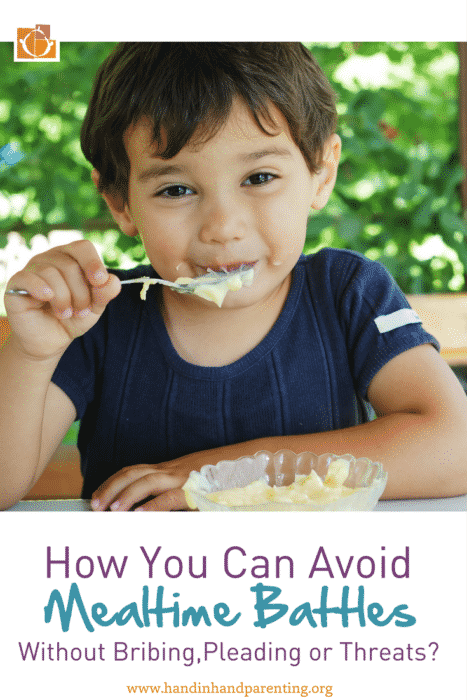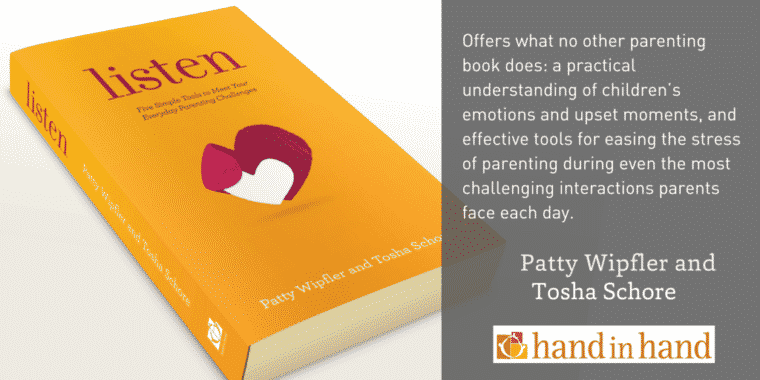![]()

We've all read the stats. Eating dinner together with our children helps with everything from language skills and emotional resilience, to avoiding drink, drugs and obesity, and scoring better grades in school later on.
So we juggle our schedules, shop with care, turn off the TV and take a break from chores. We try really hard to make sure that we can all sit down together, and what happens?
The dinner table – or even getting there – becomes a battle ground.
And no wonder. Look at the different viewpoints parents have about dinner compared to a child:
Parents need time to prep a meal.
Kids want you to come play.
Parents, flagging at the end of a day, want a little co-operation.
Kids would do anything rather than sit in a chair.
Parents want to see a wide range of rainbow foods devoured with enthusiasm.
Kids have a thing for bread. Only bread.
Day after day these differences fly back and forth so that, pretty soon, the frustration sets in as soon as we troop off to make dinner. No wonder “dinner time” looms big and heavy in our list of parent challenges.
By the time we find ourselves marching into the dining room, yelling “come eat,” to a chorus of “no's” or, perhaps worse, silence, we're ready to blow.
If we are lucky we plead, cajole, or bribe, or if we are fuming, we threaten, yell and drag a crying child to the table – again and again if you have a ‘runner.'
So what's going wrong?
According to specialists, we're missing one vital ingredient: Connection.
Humans are wired for connection, and when we miss it, which happens often, things can start to go astray. As Patty Wipfler explains in her book Listen: Five Simple Tools To Meet Your Everyday Parenting Challenges, a child's limbic system, the part of the brain that forms our social and emotional center, scans for information second by second. This radar measures sights, sounds, tastes, and body language.
By scanning the tone of voice, posture, eye contact and facial expression of the people close by, the limbic system helps children assess their safety at any given moment. It has them constantly asking “Am I wanted? Do I belong? Is someone thinking about me.”
In ancient times, this system would have protected children, enabling them to grow, and eventually, further their species, explains Wipfler.
“Children must have developed this keen awareness of the inner states of others because their lives depended on it. Long before the dawn of civilisation, a child's survival hinged on knowing which adult could meet her needs in an unpredictable environment.”
The trouble is, a lead up to any meal offers multiple opportunities for disconnection. We rush in late from classes or activities and head straight for the kitchen. Even if we do spend time before dinner hanging out with our children, connection can fray just as soon as we disappear to make food.
The younger the child, the more intense a need for connection is. And sometimes, disconnection stems from things we don't even know about, including past times of stress, or simply a bad day.
Since ordering takeout every night is not a viable plan, we have to work on other ways to boost that connection to pave the way for a smoother dinner time with our children.
What Stresses You Most About Dinner?
 Is it that your children defiantly refuse to wash up before dinner? Is it that they won't sit at the table? Is it that they are rude about the food, or won't eat anything you serve up?
Is it that your children defiantly refuse to wash up before dinner? Is it that they won't sit at the table? Is it that they are rude about the food, or won't eat anything you serve up?
As these triggers build up over time, tension rises and becomes a sore point. And guess what? The limbic system can sense that tension too, and cause a child to act up.
Parenting expert and clinical psychologist Dr. Laura Markham has some useful advice on narrowing down the triggers in her post on getting toddlers to eat. “I would suggest that families begin by clarifying their goals. Getting the toddler to eat a healthy dinner? Getting them used to eating with the family? Having a nice time for the family to connect every evening?
Work on ways to get that one goal happening, for instance, getting the family together.
Look at when dinner is and whether a child is actually hungry. Toddlers, says Dr. Markham, can't often wait past five o'clock to eat – which is often too early for other members of the family. Could they eat earlier, and enjoy a light snack at the family table if the goal is family oriented?
A snack earlier on, with a healthier sandwich or crackers, cut up veggies and dip, or fruit could also take care of the nutrition, leaving the actual dinner time less stressed.
Paving The Way for Connection Eases Dinner Time Stress
Thanks to the brain's center for reasoning, the prefrontal cortex, a child can be attentive, cooperative and engaged when he is connected, so it pays to build connection before dinner.
What builds connection? Your attention, your agreement and your approval.
The quickest and simplest way to connect with a child is laughter. That means play. The good news is you don't have to suggest much. You can plonk right down next to them and watch what they are up to. If they ask you to participate, do, but follow their lead.
Look for giggles as a sign connection is building, and encourage them. If something makes them laugh, do it again.
Other quick connection builders come through contact. Anything from challenging the kids to thumb wars or “first one to laugh loses”, pillow fighting or challenging them to knock you off the sofa.
You, or a partner if you are really tied up at the stove, can instigate this kind of play while pre-empting the transition dinner time by saying, “Before we eat who wants to play xxxxx for five minutes.”
A funny thing about building connection is that it happens faster when you lose. Why? Kids rarely see adults, bumble, stumble or fail because it's usually them struggling to lace up shoes, put on pants, pack a schoolbag, score a goal, or solve a maths problem – all easy things for adults. So when they see a grown up go down, it's hilarious for them. That guarantees laughter, and laughter brings connection. So put up a challenge, but mess up often. You'll come out the winner, but they'll never know.
If your children always cajole you into playing longer, you can even set a timer. Finish on a high when it dings by racing them to the table (and letting them beat you, of course.)
If It's Definitely Dinner, But They Still Aren't Interested
So you've played, connected and it's dinner, but your children still don't want to eat. Try a limit: “It's time to eat.”
The limit can be warm:”It's time to eat, jump on, i'll give you a piggy back to the dining room.”
It can be playful: “It's time to eat. Race you to the table.”
It can even be sympathetic: “I know you don't want to eat, but it's time.”
Still, the outcome may not always be laughter and smiles, and very often, the limit might prompt tears. But, when connection is the goal, that's okay.
“Refusal to do something ordinary, like washing hands before a meal, is usually a sign that the child is struggling,” says Patty Wipfler in Listen.
To set a limit, say what you want, and then guide the child towards making it happen. If they refuse to wash their hands, you can help them by running the taps and soaping their hands, all the way staying close and warm. If they refuse to come to the table, you can tell them, “I'll help you,” as you carry them and gently place them in their seat. If they refuse to eat, tell them to take their time.
The close physical contact and warmth in your tone tells your child's limbic system he or she is safe to let go, and sometimes that means crying about whatever is worrying them. Sometimes, you might get to hear what that worry is, but other times you'll never know. If you can stay close and say little while the tears fall, and let the crying come to it's natural conclusion, children often become brighter and more co-operative.
You can read why it's important to say little when a child cries here.
Many parents report they'll fulfill the request without ever being asked a second time.
If everyone is waiting on you and an upset child to eat, you can ease the pressure by telling them to get started. Yes, the goal might be eating together, and hopefully you'll join them, but sometimes setting new expectations takes more than one night.

How to Keep Connection High While You Eat
Laughter and play comes in just as useful when a child keeps slipping off his seat, or isn't interested in the food that's served. If a child keeps moving, try taking some imaginary glue, and “gluing” her to the seat. See how long it holds!
Or, if your child says he hates broccoli, you can pick up a piece, eat it, make disgusted faces and call it the worst food of all time. Or turn the offensive food into a sad little character, so unhappy that “No-one wants to eat meeeee!”
As long as there is one healthy thing on the plate that he will eat, try not to stress about he won't eat. These two ideas are included in 20 Playful Ways To Help Picky Eaters by Hand in Hand Parenting Instructors.
“Stop any discussion about what he eats, or how much he eats,” says Amy McCready, Founder of Positive Parenting Solutions, in this post on getting kids to eat what the family eats.
Rather than requiring a child to”try a little bit,” “eat one of everything”, or “finish his plate,” which results in a power play, McCready advises making what a child eats their problem, not yours. Offer a healthy range, including some things a child likes, and set a limit that you will not offer any other food until the next scheduled meal or snack.
Then, leave them to eat what they will, without comment. They may eat, or they not, she says. “Children will not starve by missing one meal – I promise!”
Over time, the expectation becomes that the family will eat together. And most times, those dinner times will be a good place to be. A place where parents and children can share the joke, be a bit silly, enjoy some food, but more importantly spend time together.
More a meeting ground than a battleground, a place where it's fine to play with your food.
Get a guide to Setting Limits without yelling or shame here.
What to do When Toddlers Bite? Get help here.
